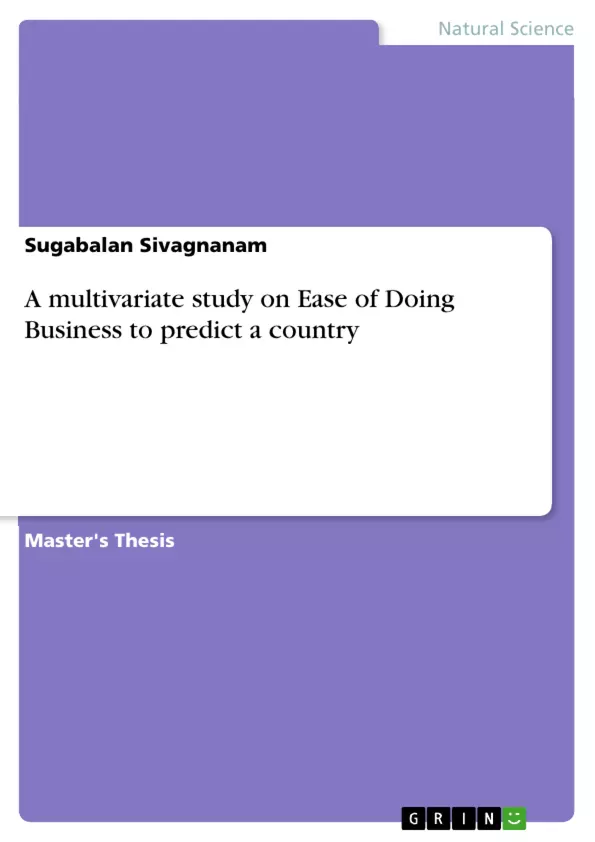The Doing Business Report (DB) is a study elaborated by the World Bank Group since 2003 every year that is aimed to measure the costs to firms of business regulations in 189 countries in 2012.The study has become one of the flagship knowledge products of the World Bank Group in the field of Private Sector development, and is claimed to have motivated the design of several regulatory reforms in developing Countries. The study presents every year a detailed analysis of costs, requirements and procedures. A specific type of Private Firm is subject in all countries, and then, creates rankings for every country. The study is also backed up by broad communication efforts, and by creating rankings, the study spotlights countries and leaders that are promoting reforms.
Inhaltsverzeichnis (Table of Contents)
- ACKNOWLEDGEMENT
- INTRODUCTION
- 1.1 Doing Business
- 1.2 Ease of doing business index
- 1.3 Starting a Business Methodology
- 1.4 Dealing with Construction Permits Methodology
- 1.5 Getting Electricity Methodology
- 1.6 Registering Property Methodology
- 1.7 Getting Credit Methodology
- 1.8 Protecting Investors Methodology
- 1.9 Paying Taxes Methodology
- 1.10 Trading Across Borders Methodology
- 1.11 Enforcing Contracts Methodology
- 1.12 Resolving Insolvency Methodology
- 1.13 OBJECTIVES
- 1.14 SOURCE OF DATA
- 1.15 VARIABLE DESCRIPTION
- 1.16 PROCEDURES
- METHODOLOGY
- 2.1 Factor Analysis
- 2.1.1 Introduction
- 2.1.2 Orthogonal Transformation
- 2.1.3 Assumption
- 2.1.4 Parameter Reduction
- 2.1.5 Trivial case
- 2.1.6 Principal Component (Principal Factor) Method
- 2.1.7 Factor Rotation
- 2.1.8 Criterion for choosing the orthogonal matrix [Varimax criterion]
- 2.1.9 Factor Scores
- 2.2 MULTIPLE LINEAR REGRESSIONS
- 2.2.1 Data and Sample regression model
- 2.2.2 Assumptions
- 2.2.3 Estimation of the regression parameters
- 2.2.4 Properties of LSE's
- 2.2.5 Prediction and Residuals
- 2.2.6 Decomposition of the overall variability in the data
- 2.2.7 Estimation of σ²
- 2.2.8 Hypothesis Testing in multiple linear regressions
- 2.2.9 Coefficient of determination (R²) and Adjusted R²
- 2.2.10 Multicollinearity
- 2.2.11 Multicollinearity Diagnostics
- 2.2.12 Remedial Measures for Multicollinearity
- ANALYSIS & OUTPUT
- 3.1 Factor Analysis
- 3.2 Multiple Linear Regressions
- 3.3 Variance Inflation Factors
- 3.4 Rank Method
- CHAPTER 4
- CONCLUSIONS
- 4.1 Conclusions
- CHAPTER 5
Zielsetzung und Themenschwerpunkte (Objectives and Key Themes)
The project aims to analyze the factors influencing the ease of doing business in different countries using a multivariate approach. The study employs factor analysis and multiple linear regressions to understand the relationship between various business environment indicators and the overall ease of doing business ranking.- Ease of doing business index and its components
- Multivariate statistical techniques for data analysis
- Relationship between business environment indicators and ease of doing business
- Predicting a country's ranking based on various business environment indicators
- Identifying key factors influencing ease of doing business
Zusammenfassung der Kapitel (Chapter Summaries)
- Introduction: This chapter provides an overview of the ease of doing business index, its significance, and the various indicators used to measure it. It also introduces the methodologies used to collect data for each indicator, including starting a business, dealing with construction permits, getting electricity, registering property, getting credit, protecting investors, paying taxes, trading across borders, enforcing contracts, and resolving insolvency. The chapter concludes by outlining the objectives of the project and describing the data used and variables analyzed.
- Methodology: This chapter discusses the statistical methods used for data analysis, including factor analysis and multiple linear regressions. It delves into the theoretical underpinnings of both techniques, outlining their key features and assumptions. The chapter also explores concepts such as orthogonal transformation, factor rotation, and multicollinearity, explaining their relevance in the context of the project.
- Analysis and Output: This chapter presents the results of the data analysis, applying the methods described in the previous chapter to the collected data. It discusses the factors influencing the ease of doing business, explores the relationships between various indicators, and provides insights into the model's predictive capabilities. The chapter also includes analysis of variance inflation factors and explores the use of ranking methods to identify key factors.
- Conclusions: This chapter summarizes the main findings of the project, highlighting the key factors influencing the ease of doing business in different countries. It discusses the implications of the results for policymakers and businesses, providing recommendations for improving the business environment and fostering economic growth.
Schlüsselwörter (Keywords)
The main keywords of this project include Ease of Doing Business, World Bank, Business Environment, Factor Analysis, Multiple Linear Regression, Multicollinearity, Variance Inflation Factors, and Country Rankings. These keywords represent the core concepts and research focus of the study, exploring the complex relationship between various business environment indicators and the overall ease of doing business in different countries. The research aims to provide insights into the factors influencing a country's ranking and offers valuable recommendations for improving business environments globally.- Quote paper
- Sugabalan Sivagnanam (Author), 2014, A multivariate study on Ease of Doing Business to predict a country, Munich, GRIN Verlag, https://www.grin.com/document/277375



